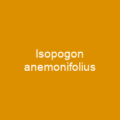Isopogon anethifolius is a shrub in the family Proteaceae. The species is found only in coastal areas near Sydney in New South Wales. It regenerates after bushfire by resprouting from its woody base, known as a lignotuber.
About Isopogon anethifolius in brief

The common name is variously written as narrowleaf-, narrow- leaf-, or narrow-leafed drumsticks The common drumsticks is the globular yellow flowerhead of the members of the genus Protea acufera, derived from the Latin words anethum \”dill\” and folium \”leaf\”, from the resemblance of its leaves to those of the herb. The egg-shaped grey cones are revealed as the old flower parts fall away, and are up to 2. 5 cm in diameter. The seed-bearing nuts are small—up to 4 mm across—and lined with hairs. The seed weighs around 4 mg. The plant is one of the easiest to grow in cultivation, if located in a sunny or part-shaded spot with sandy soil.
You want to know more about Isopogon anethifolius?
This page is based on the article Isopogon anethifolius published in Wikipedia (as of Dec. 01, 2020) and was automatically summarized using artificial intelligence.







